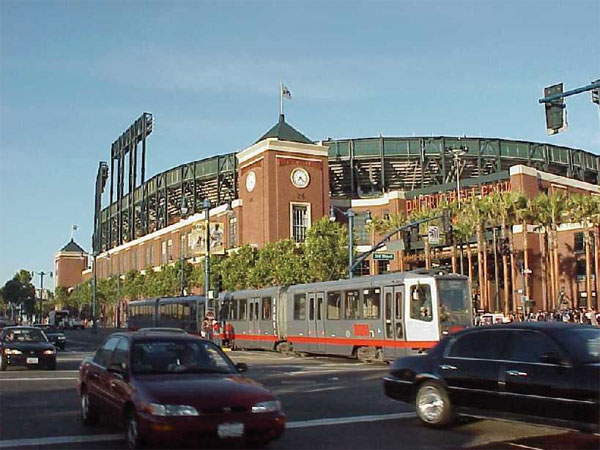Pac Bell (SBC) Park - San Francisco, CA
FAST FACTS ABOUT: Pac Bell (SBC) Park
Types of TDM: Transit service improvements, information
and incentives, and parking management
Keywords: Special events, multi-jurisdictional coordination,
transportation management plan, neighborhood impacts, parking pricing
Area Demographics: Professional sports stadium in rehabilitated
warehouse district proximate to regional commuter rail and light rail
service. PacBell Park (now SBC Park) is situated in South or Market
district adjacent to San Francisco Bay.
Program: Transportation Management Program (TMP) was
a required by City. Ballpark Transportation Coordinating Committee appointed
to develop TMP among stakeholders.
Results: Achieve objective of 50% of fans arriving
by non-auto modes. Parking lots never full to capacity.
Cost of Program: $1.5 million spent on transportation
facility improvements and information campaign.
Contact: Gerald Robbins, City and County of San Francisco
Planning Department

A New Downtown Ballpark for the SF Giants
Pacific Bell Park, the San Francisco Giants 41,000-seat “downtown
ballpark,” opened in March 2000. The ballpark is located alongside
San Francisco Bay, approximately one mile (1.6 km) south of the center
of downtown San Francisco. The ballpark is located in the South of Market
Area (SOMA) of San Francisco, a former warehouse district that in recent
years has become a popular location for new technology firms and high-density
residential development. The ballpark site is relatively small and is
bounded by water on two sides. Unlike most sports stadia, PacBell park
and its parking lots were constructed almost entirely with private funds.
As a result, very little funding (about $1.5 million) was available
for off-site transportation improvements, such as improved roadway,
transit or pedestrian facilities. However, the Giants promoted the downtown
site, in part, because of its proximity to regional transit and existing
commuter-oriented parking supply. Additionally, the ballpark planners
also hoped that many downtown workers would walk or ride bicycles to
PacBell park on weekdays. Traffic concerns included the fact that weekday
afternoon ball games would be over within close proximity to the start
of the evening rush hour.
TMP Required by City
Due in part to concerns of local residents and businesses about traffic
congestion, particularly for weekday afternoon games, the City and County
of San Francisco required a Transportation Management Plan (TMP) be
developed and approved to assure efficient transportation operations
and minimal impacts to the surrounding neighborhoods. A Ballpark Transportation
Coordinating Committee (BTCC) was appointed to develop the TMP and garner
buy-in from affected parties. One key objective of the TMP was to maximize
the use of non-auto modes by baseball fans, particularly public transit.
The TMP included the promotion of existing and new transit services:
• Caltrain commuter rail service terminus adjacent to the ballpark.
• A new LRT line from Caltrain to BART Embarcadero station.
• Nearby BART regional rail under Market Street.
• New ferry service to the adjacent China Basin Ferry Terminal.
• Various SF Muni bus lines and regional bus service to the Transbay Terminal.
The Giants and regional transportation agencies educated fans on the potential traffic and parking problems and the range of convenient and affordable transit options.
PacBell has 5,000 dedicated parking spaces in lots located across Mission
Creek. New residential area parking restrictions were imposed and several
streets and lanes closed during games (including access routes to the
parking lots and regional transit service).
Finally, a set of transit promotional activities and incentives were
part of a comprehensive marketing campaign called “Your Ticket
Home” and were funded by the Giants, the Metropolitan Transportation
Commission, and several corporate sponsors. The campaign was designed
to entice first time user to try transit and included the following
components:
• A pocket-size pocket information guide for fans and all season ticket holders.
• A transit information hotline answered by the regional ridesharing organization.
• The opportunity to purchase transit tickets by mail (resulting in over $100,000 in advanced fares purchases).
• An incentive program that rewarded Giants fans points toward their fan appreciation program for purchasing transit tickets.
• Promotion of the Your Ticket Home campaign on Bay Area trains and buses serving the ballpark.
• The deployment of “Transit Ambassadors” to answer questions and guide new riders through transfers and fare collection particulars.
Half of Giants fans arrived by non-auto modes and parking lots were never full to capacity due to the effectiveness of the TMP.
Better than Expected Results
The primary measures of success were the proportion of fans arriving
by transit and the severity of traffic and parking congestion. During
the first year in PacBell Park (renamed SBC Park in 2004), the ballpark
and its TMP achieved a 50% non-auto mode split and the dedicated parking
lots never reached capacity.
Part of the evaluation of the TMP’s effectiveness was a comparison
of the first year operation of PacBell Park with 3Com (formerly Candlestick
Park). Some key comparisons are provided below and bear witness to the
success of the TMP:

What do the Giants and City of San Francisco attribute the high transit
usage and lack of parking and severe traffic problems? First, pre-opening
public information not only educated fans as to the lack of parking
and congested downtown streets, but one the range of affordable transit
options. Pre-paid transit ticket opportunities and a high proportion
of advance payment season ticket holders provided fans with ample time
to plan their trip to the ballpark and reduce spur of the moment travel
(more commonly made by car). A significant percentage of fans at weekday
(32%) and weeknight (28%) games came to the ballpark directly from work.
The high level of transit use at PacBell can be attributed to the following
factors: 1) availability of reliable, efficient, and affordable mass
transit; 2) commitment to quality transit service by regional providers
and the Giants made possible by predictable ridership; 3) high parking
costs and limited availability; 4) close proximity to a large downtown
population base; a well developed and executed transportation management
plan; and 5) public expectations as to the severity of traffic and parking
problems.